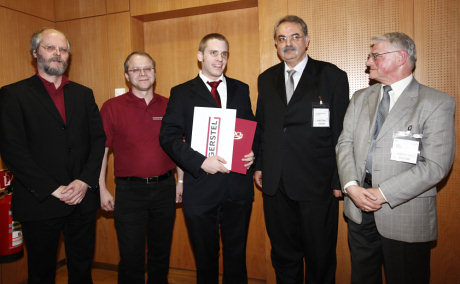The Eberhard-Gerstel Award, for the first time presented during the Analytica 2010, was given to Dr. Jens Künnemeyer from the University of Münster for his outstanding contribution in the area of speciation analysis. The young scientist had published a new method for the separation and determination of Gd-based contrast agents in water samples by means of an hyphenated technique using hydrophilic interaction liquid chromatography (HILIC).
The award, worth 2000 €, was given during the second day of 22nd International Trade
Fair for Laboratory Technology, Analysis, Biotechnology and analytica
Conference (
analytica 2010) by
Gerstel (represented by
its executive directors Eberhard Gerstel and Holger
Gerstel) and the GdCh working group "Separation Science" (represented by
Klaus Bischoff and Prof. Dr. Werner Engewald).

Photo: (from left to right): Eberhard Gerstel, Holger Gerstel (executive directors Gerstel GmbH & Co. KG), Dr. Jens Künnemeyer, Klaus Bischoff (Chairman of the GDCh-Working Group Separation Science) and Prof. Dr. Werner Engewald (honorary chairman AK Separation Science) (Photo: GERSTEL)Dr. Jens Künnemeyer was awarded for his work that was prepared during his doctorial thesis in the
working group of Prof. Karst at the
Institute for Inorganic and Analytical Chemistry of the
University of Münster. In search for a highly efficient method for the separation and determination of Gd-based contrast agents in samples such as waste water, Jens Künnemeyer had developed a method for ICP-MS based detection using HILIC for separation. Gd-based contrast agents are used about 20,000,000 times a year for medical diagnosis using
nuclear magnetic resonance imaging (NMRI). While free Gd is highly toxic, Gd in admitted Gd-based contrast agents is fixed in very stable complexes and therefore generally considered to be safe. However, in rare cases always related to renal failure patients, severe side effects resulting in
Nephrogenic systemic fibrosis (NSF) have been observed. Besides such severe effects Jens Künnemeyer was also interested to study whether the stable Gd-complexes can still be found in hospital waste water receiving the urine from patients treated with the contrast agents. Using the developed HILIC-ICP-MS method, Künnemeyer was able to show that Gd-based contrast agents survive both human metabolism and waste water treatment.
 The awarded publication
The awarded publication
Jens
Künnemeyer, Lydia Terborg, Björn Meermann, Christine Brauckmann, Ines
Möller, Andy Scheffer,
Uwe
Karst,
Speciation Analysis of
Gadolinium Chelates in Hospital Effluents and Wastewater Treatment Plant
Sewage by a Novel HILIC/ICP-MS Method,
Environ. Sci. Technol.,
43/8 (2009) 2884-2890.
DOI:
10.1021/es803278n Related EVISA Resources
Related EVISA Resources Link Database: Toxicity of Gadolinium compounds
Link Database: Toxicity of Gadolinium compounds Materials Database: Gadolinium Materials
Materials Database: Gadolinium Materials Brief Summary: ICP-MS: A versatile detection system for speciation
analysis
Brief Summary: ICP-MS: A versatile detection system for speciation
analysis Brief Summary: LC-ICP-MS: The most often used hyphenated system for
speciation analysis
Brief Summary: LC-ICP-MS: The most often used hyphenated system for
speciation analysis Company Database: Gerstel and their products
Company Database: Gerstel and their products Related EVISA News (newest first)
Related EVISA News (newest first)
 March 14, 2016: Tracing Gadolinium-based Contrast Agents from Wastewater, via Surface Water to Drinking Water
March 14, 2016: Tracing Gadolinium-based Contrast Agents from Wastewater, via Surface Water to Drinking Water
 March 4, 2015: Detection of Gd-based contrast agent in the skin of a patient eight years after administration
March 4, 2015: Detection of Gd-based contrast agent in the skin of a patient eight years after administration  October 29, 2012: Identification and quantification of potential metabolites of Gd-based contrast agents
October 29, 2012: Identification and quantification of potential metabolites of Gd-based contrast agents  October 18, 2012: The behavior of Gd-based contrast agents during wastewater treatment
October 18, 2012: The behavior of Gd-based contrast agents during wastewater treatment September 15, 2010: US FDA Announces Gadolinium-Based MRI Contrast Agent Warning
September 15, 2010: US FDA Announces Gadolinium-Based MRI Contrast Agent Warning May 4, 2009: Gadolinium speciation analysis in search for
the cause of nephrogenic systemic fibrosis (NSF)
May 4, 2009: Gadolinium speciation analysis in search for
the cause of nephrogenic systemic fibrosis (NSF) April 17, 2009: Gadolinium-based MRI contrast agents found
intact in the outlet of a waste water treatment plant
April 17, 2009: Gadolinium-based MRI contrast agents found
intact in the outlet of a waste water treatment plantlast time modified: May 20, 2024